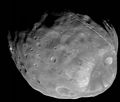Talaksan:Phobos colour 2008.jpg

Laki ng pasilip na ito: 636 x 600 na pixel. Ibang mga resolusyon: 255 x 240 na pixel | 509 x 480 na pixel | 815 x 768 na pixel | 1,086 x 1,024 na pixel | 2,172 x 2,048 na pixel | 3,500 x 3,300 na pixel.
Buong resolusyon ((3,500 × 3,300 pixel, laki ng talaksan: 2.72 MB, uri ng MIME: image/jpeg))
Nakaraan ng file
Pindutin ang araw/oras upang makita kung papaano ang itsura ng talaksan noong oras na iyon.
| Araw/Oras | Thumbnail | Mga dimensiyon | tagagamit | Kumento | |
|---|---|---|---|---|---|
| ngayon | 03:10, 2 Abril 2018 |  | 3,500 × 3,300 (2.72 MB) | Kaldari | more margin on right side |
| 04:47, 13 Nobyembre 2008 |  | 3,374 × 3,300 (2.7 MB) | Fir0002 | == Summary == {{Information |Description=Colour image of Phobos, imaged by the Mars Reconnaisance Orbiter in 2008 |Source=NASA |Date=9 April 2008 |Location=http://www.nasa.gov/mission_pages/MRO/multimedia/pia10368.html |Author=NASA/J |
Mga ugnay
Nakaturo sa talaksan na ito ang mga sumusunod na mga pahina:
Pandaigdigang paggamit sa file
Ginagamit ng mga sumusunod na wiki ang file na ito:
- Paggamit sa af.wikipedia.org
- Paggamit sa an.wikipedia.org
- Paggamit sa ar.wikipedia.org
- المريخ
- فوبوس
- قمرا المريخ
- ويكيبيديا:صور مختارة/الفضاء والكون/نظرة إلى الأعلى
- قائمة أجرام المجموعة الشمسية مرتبة حسب الحجم
- بوابة:علم الفلك/صورة مختارة
- بوابة:المريخ
- بوابة:المريخ/مقالة مختارة/أرشيف
- بوابة:المريخ/مقالة مختارة/2
- قائمة الأقمار الطبيعية
- خط زمني لاكتشاف كواكب المجموعة الشمسية وأقمارها
- ويكيبيديا:ترشيحات الصور المختارة/القمر فوبوس
- ويكيبيديا:صورة اليوم المختارة/أغسطس 2019
- قالب:صورة اليوم المختارة/2019-08-03
- بوابة:علم الفلك/صورة مختارة/73
- معسكر قاعدة المريخ
- ويكيبيديا:صورة اليوم المختارة/يناير 2022
- قالب:صورة اليوم المختارة/2022-01-04
- Paggamit sa ary.wikipedia.org
- Paggamit sa arz.wikipedia.org
- Paggamit sa as.wikipedia.org
- Paggamit sa azb.wikipedia.org
- Paggamit sa az.wikipedia.org
- Paggamit sa be-tarask.wikipedia.org
- Paggamit sa be.wikipedia.org
- Paggamit sa bg.wikipedia.org
- Paggamit sa bh.wikipedia.org
- Paggamit sa bn.wikipedia.org
- Paggamit sa bn.wikibooks.org
- Paggamit sa bs.wikipedia.org
Tingnan ang karagdagang pandaigdigang paggamit sa file na ito.





